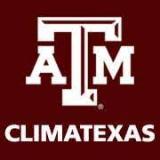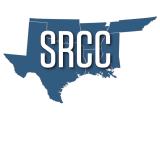Multi-Year Drought Impacting Western Kansas, Western Oklahoma, and Much of Texas
Key Points
- Exceptional (D4) drought persists across southern Kansas (36% of the state), Oklahoma (13%), and Texas (4%).
- Spring is usually the wettest time of the year, but drought in the Panhandle region is expected to remain into summer.
- Severe fire danger will remain a frequent hazard for western Kansas/Oklahoma/Texas, and the Oklahoma/Texas panhandles through spring. In the Texas Panhandle, nearly 9,500 acres burned on Tuesday, April 4, due to extremely low humidities, winds gusting to 70 mph, and the long-term drought.
- Expanding drought over Edwards Plateau, south-central Texas, and the region of the Edwards Aquifer (a water source for San Antonio and much of central Texas) has dropped well-water levels to the second lowest point on record.
- The two largest reservoirs along the Rio Grande, Falcon Lake and Lake Amistad, are at their lowest levels since 1990 for this time of year, at 11% and 37% full respectively.
- During the first 3 months of 2023, inflows into the Highland Lakes, which feed the Colorado River from the Texas Hill Country downstream, were only 12% of the median value over the past 80 years, with only 1952 and 1954 being less.
- Winter wheat conditions as of April 2:
- The Panhandle region has been experiencing frequent dust storms.
The U.S. Drought Monitor is updated each Thursday to show the location and intensity of drought across the country. Drought categories show experts’ assessments of conditions related to dryness and drought including observations of how much water is available in streams, lakes, and soils compared to usual for the same time of year.
This map shows drought conditions across the Southern Plains Drought Early Warning System as of April 4, 2023.
U.S. Drought Monitor Categories
Abnormally Dry (D0)
Abnormally Dry (D0) indicates a region that is going into or coming out of drought. View typical impacts by state.
Moderate Drought (D1)
Moderate Drought (D1) is the first of four drought categories (D1–D4), according to the U.S. Drought Monitor. View typical impacts by state.
Severe Drought (D2)
Severe Drought (D2) is the second of four drought categories (D1–D4), according to the U.S. Drought Monitor. View typical impacts by state.
Extreme Drought (D3)
Extreme Drought (D3) is the third of four drought categories (D1–D4), according to the U.S. Drought Monitor. View typical impacts by state.
Exceptional Drought (D4)
Exceptional Drought (D4) is the most intense drought category, according to the U.S. Drought Monitor. View typical impacts by state.
The U.S. Drought Monitor is updated each Thursday to show the location and intensity of drought across the country. Drought categories show experts’ assessments of conditions related to dryness and drought including observations of how much water is available in streams, lakes, and soils compared to usual for the same time of year.
This map shows drought conditions across the Southern Plains Drought Early Warning System as of April 4, 2023.
U.S. Drought Monitor
- 79% of the Southern Plains region is in drought (D1 or worse), according to the U.S. Drought Monitor.
- 26% of the region is experiencing extreme (D3) drought or worse.
- 11% of the region is experiencing exceptional (D4) drought.
- 38% of Kansas is now in D4 status, which is currently the largest percentage of D4 of any U.S. state (Oklahoma is second at 15%).
- Extreme (D3) drought conditions have been in place in this region since August 2019.
- Moderate (D1) or worse drought has been in the region since June 2016.
Recent Precipitation and Temperature Conditions
- Across Oklahoma, Interstate-44 divided the region, with above-normal precipitation in the southeast and below-normal precipitation in the northwest.
- Parts of southern Kansas and northern Oklahoma experienced the driest March on record.
Temperature and Precipitation Percentiles: March 2023
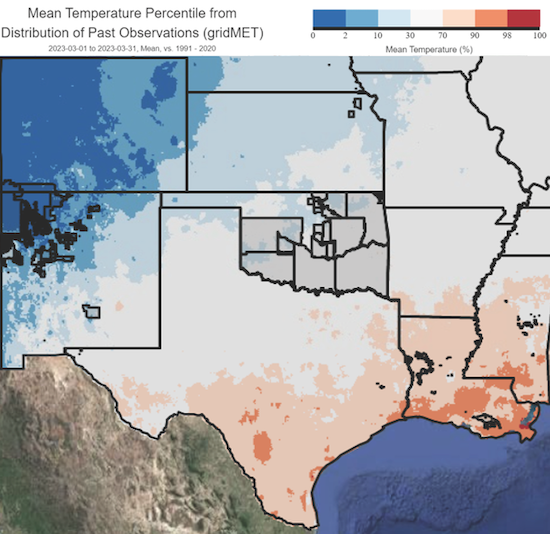
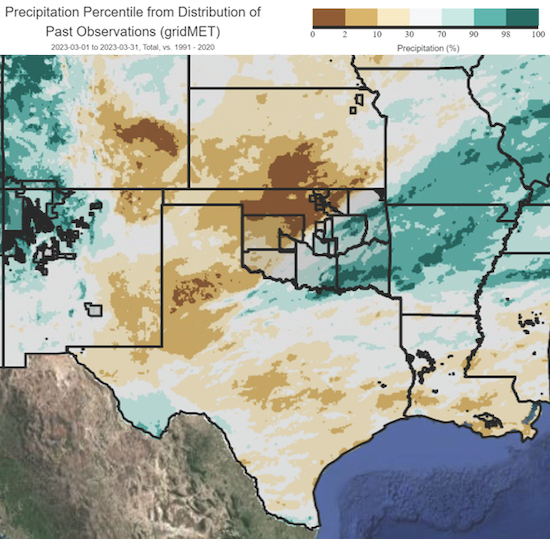
- So far, this year has been very dry across most of the Southern Plains, with parts of southwestern Kansas and the Texas and Oklahoma panhandles seeing precipitation within the bottom 10% of historical records for this time of the year.
- Central Texas has also seen a prolonged dry spell this year. The Edwards Plateau region (south-central Texas) year-to-date precipitation is in the bottom 10% of historical records, and the year-to-date temperatures are in the highest 10% of historical records.
Temperature and Precipitation Percentiles: Calendar Year to Date
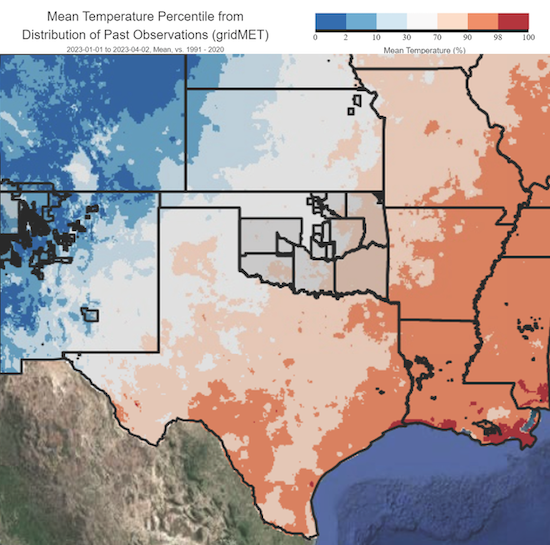
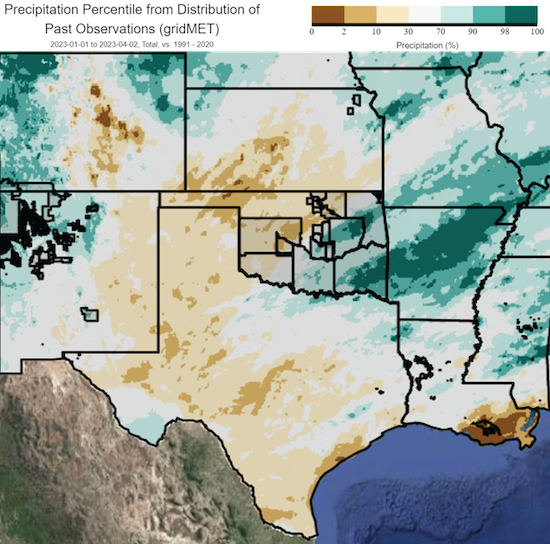
Drought Through Winter: December 2022–February 2023
- A record-setting drought has been crippling agriculture in western Kansas and parts of Oklahoma through winter.
- Winter temperatures: Overall, winter was warmer than average for the Southern Plains.
- Winter precipitation: While both Kansas and Oklahoma state-wide precipitation was near average to a little above average for winter, this precipitation was not evenly distributed across each state. Parts of western Kansas and the Oklahoma and Texas panhandles had monthly rainfall in the lowest 10% of historical records.
Winter 2022–2023 Temperature and Precipitation Percentiles
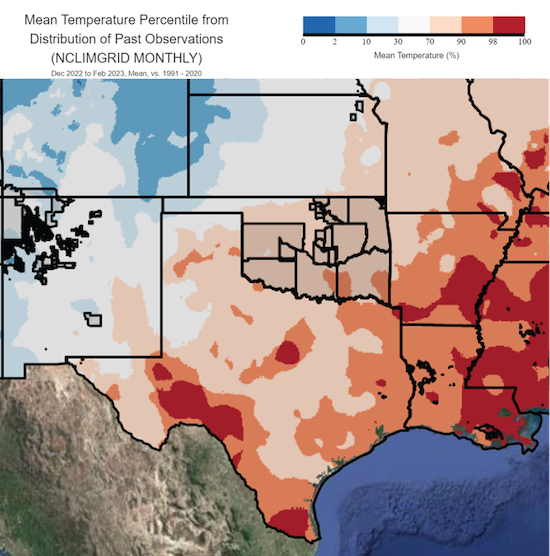
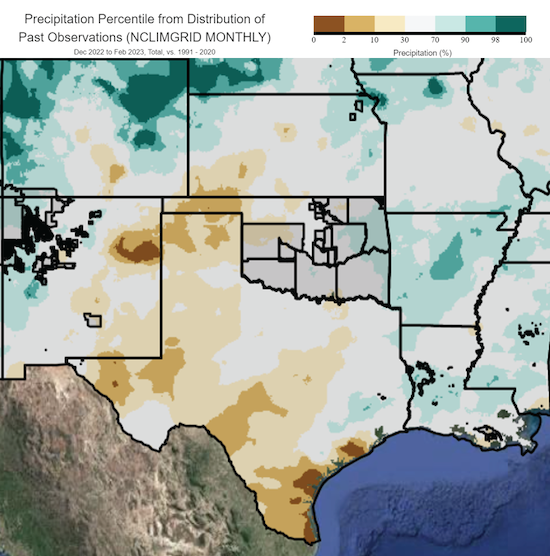
Topsoil Moisture Conditions
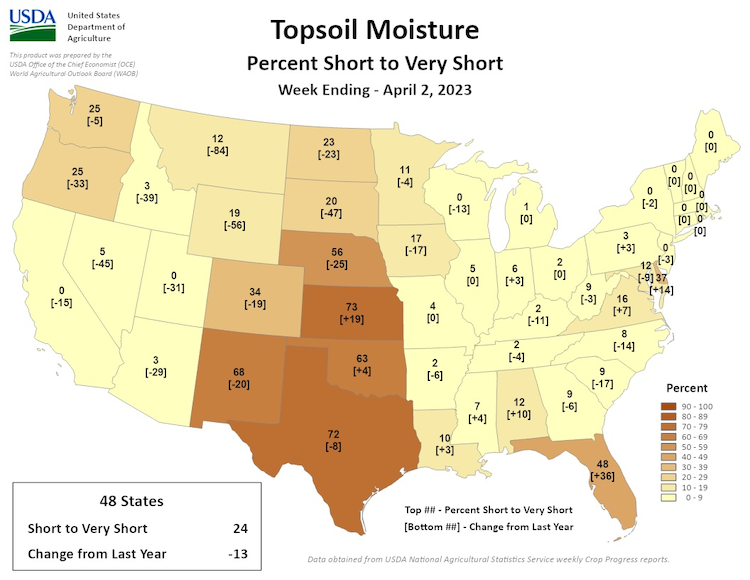
Southern Plains Drought in the News
- DTN: Stifling Drought Continues In Southern Plains
- Gro Intelligence: Drought-Ravaged Southern Plains Wheat Abandoned Acres to Soarwest — and what it might mean for next year
- 12 News: Kansas drought impacting groundwater levels
- Washington Post: Kansas Is Showing What a Drier Future Looks Like
- KU Today: Groundwater Levels Fall Across Western and South-Central Kansas
- KSN: Kansas Wheat Crop Continues to Struggle
- Successful Farming: Less than 20% of Kansas Winter Wheat is in Good to Excellent Condition
- The Journal Record: Drought, population growth spur Dust Bowl fears
- Austin American Statesman: April showers could bring much-needed relief amid Central Texas drought conditions
- AXIOS Austin: Drought persists in Central Texas over winter
- KSNT: Drought forces more coyotes into Kansas towns
- Amarillo Globe: Evacuations lifted, highway reopened; fire near Amarillo grows to est. 8,000 acres
How Will Drought Conditions Change Through Spring 2023?
Late Spring and Early Summer Usually See the Most Rain
- May and June are usually the wettest months of the year for Kansas, Oklahoma, and Texas.
- Summer months can act as a “reset” on drought conditions in average to above-average seasons.
Kansas Monthly Average Precipitation
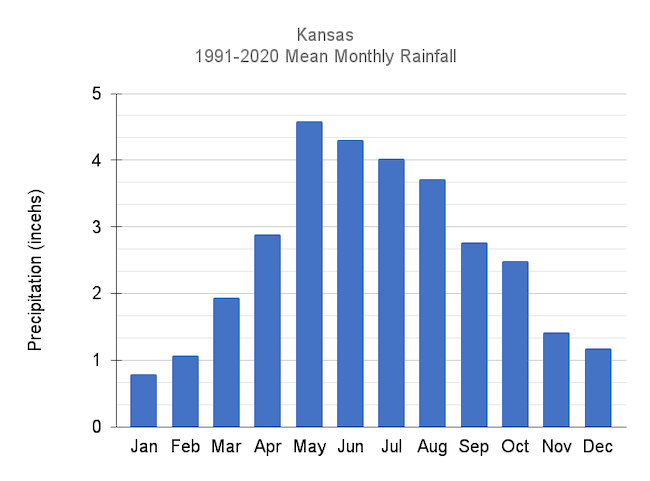
Oklahoma Monthly Average Precipitation
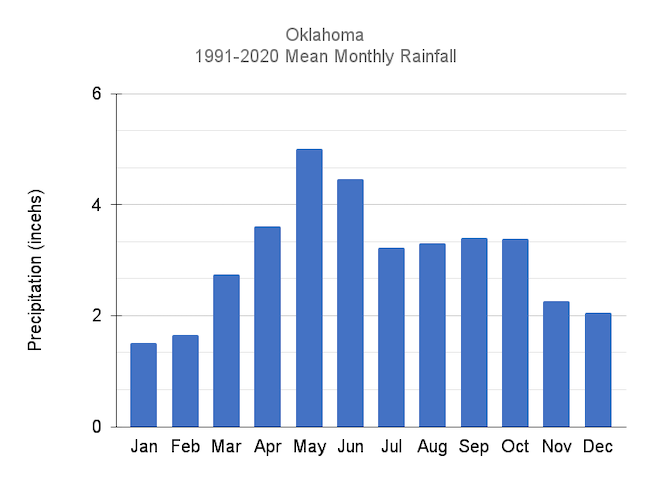
Texas Monthly Average Precipitation
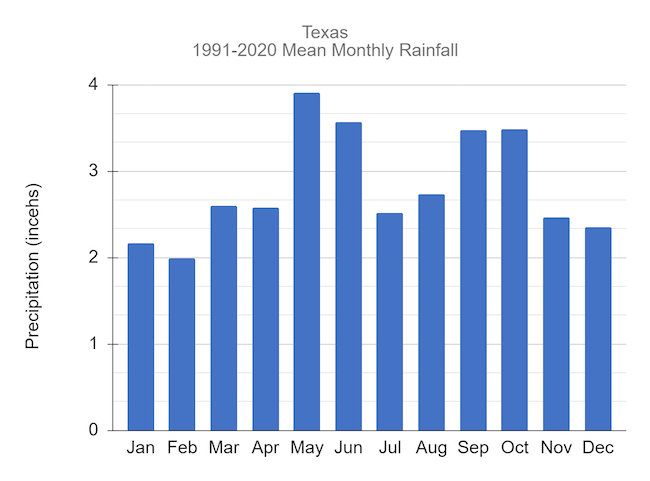
Forecasts and Seasonal Outlooks: April 2023
The Climate Prediction Center's monthly outlook for April shows:
- Temperature: April is likely to be warmer than normal for Texas, Oklahoma, and southeastern Kansas.
- Precipitation: Odds favor a wet April for eastern Texas, with near equal chances for above- or below-normal precipitation for the rest of the Southern Plains.
April 2023 Temperature Outlook
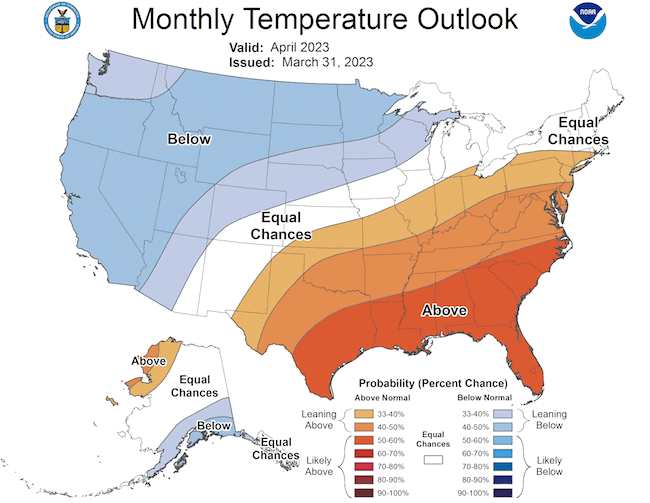
April 2023 Precipitation Outlook
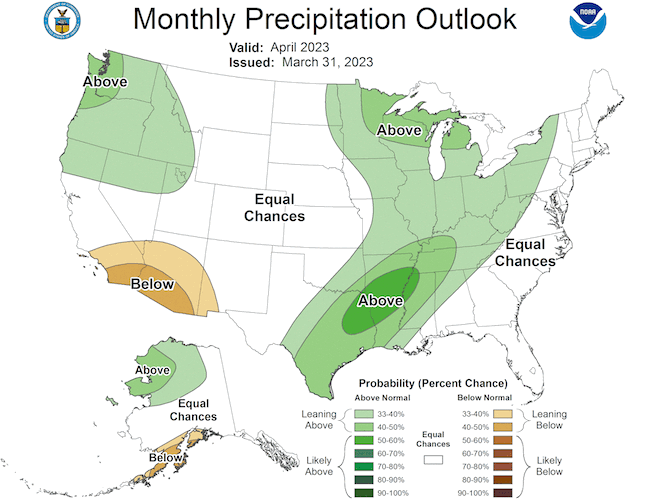
3-Month Outlook for April–June 2023
Seasonal outlooks for April–June 2023 show a warmer than normal season ahead for the Southern Plains region. Precipitation is likely to be below normal for eastern New Mexico and western Texas, with near equal odds of above- or below-normal precipitation elsewhere in the Southern Plains.
Seasonal Temperature Outlook: April–June 2023
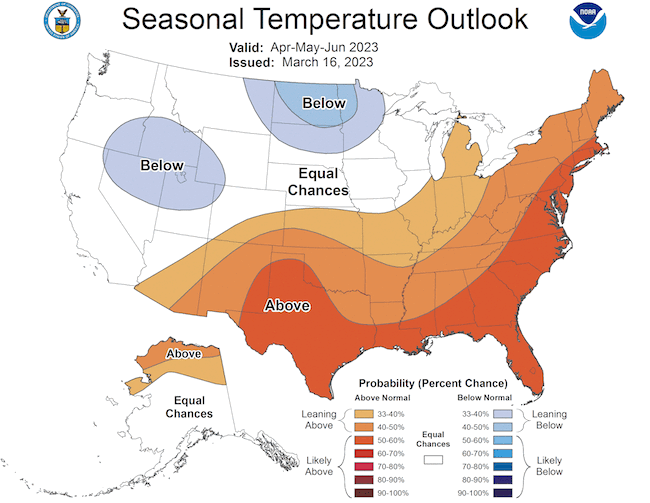
Seasonal Precipitation Outlook: April–June 2023
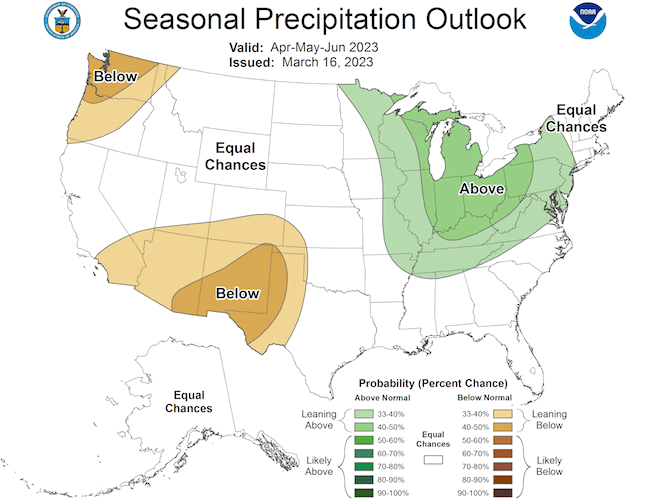
Seasonal Drought Outlook for April–June 2023
Drought in western Kansas, Oklahoma, and Texas is forecast to persist through early summer with some improvement across the central parts of each of these states.
3-Month U.S. Drought Outlook
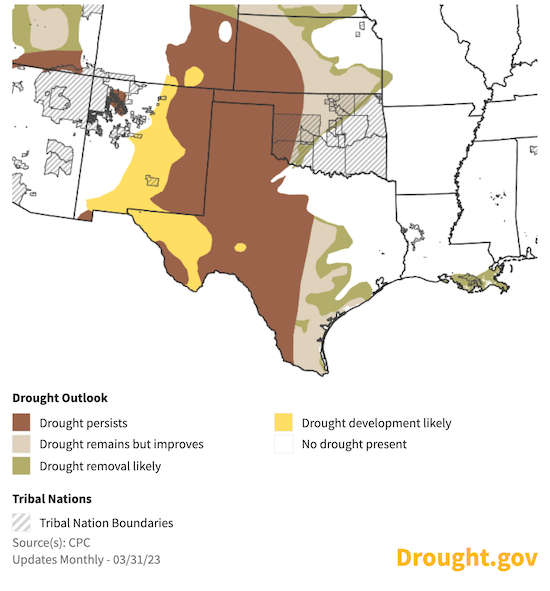
State-Based Conditions and Impacts
Kansas
- In Kansas, only two of the nine climate divisions are running above normal for the year (northeast and east central). All but one were above normal for the year prior to March; a very dry month (26% of normal statewide) led to the current deficits.
- 16% of the state is drought free; this is an increase of 15% since the start of the year. Plentiful moisture in the northeast and east central areas earlier in the year led to the improvements.
- A total of 38% of the state is in exceptional drought (D4). The composite Drought Severity Coverage Index has been over 300 for 28 consecutive weeks, the longest stretch in a decade.
- Goodland in northwest Kansas has received 40.6 inches of snowfall since September 1. This is over a foot above normal. The frequent snow events in this part of the state kept this area much cooler than the remainder of the state. For the first three months of 2023, the average temperature in northwest Kansas was 2.5 degrees below normal.
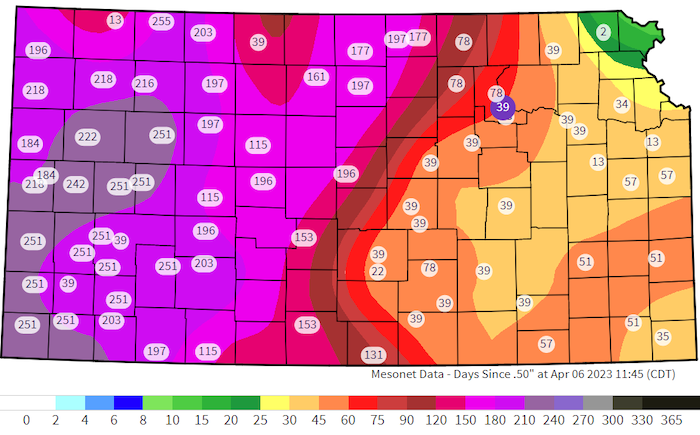
Oklahoma
- The rainfall disparity centered roughly along the Interstate 44 corridor continued to sharpen and intensify through the first 3 months of 2023.
- Areas to the north and west of I-44 recorded 1–3 inches of rainfall in 2023, generally speaking, while areas to the south and east enjoyed totals of 9–15 inches or more.
- Wildfire danger remains particularly high across the northwestern half of the state where green up has been delayed by drought.
- The Oklahoma Mesonet site at Goodwell broke the record for all-time lowest annual precipitation total with 6.48 inches in 2022. The previous record was 6.53 inches at Regnier in 1956. Goodwell has received 0.6 inches through March 31 in 2023.
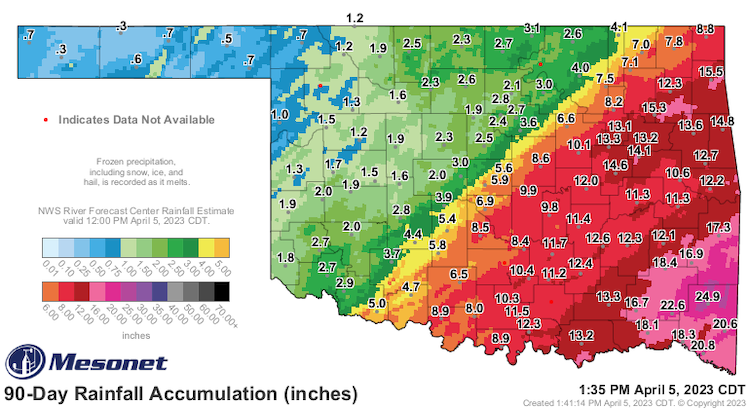
Texas
- Wildfire potential is forecasted to be high through the panhandle, plains, Trans Pecos, and western portion of the Hill Country. This is due to widespread critically dry vegetation and the likelihood of extreme fire weather. Currently, the Bent Willow fire north of Amarillo is estimated to be 8,500 acres with 30% containment.
- Water storage for South Texas and the Rio Grande Valley remains at record lows for the time of year. Amistad Reservoir is down to 37.4% full, and Falcon is down to 11.2% full. Both reservoirs are shared between the United States and Mexico.
- The Highland Lake Reservoirs (Central Texas) are at the 3rd lowest value on record (period of record 1942 to present), while March 2023 was the 5th lowest March on record. San Marcos Springs at San Marcos remains at a record low, and Barton Springs at Austin is right on the edge of record low for the time of year.
- Statewide, reservoirs across Texas are 74.6% full. This is about 10% below the long-term average.
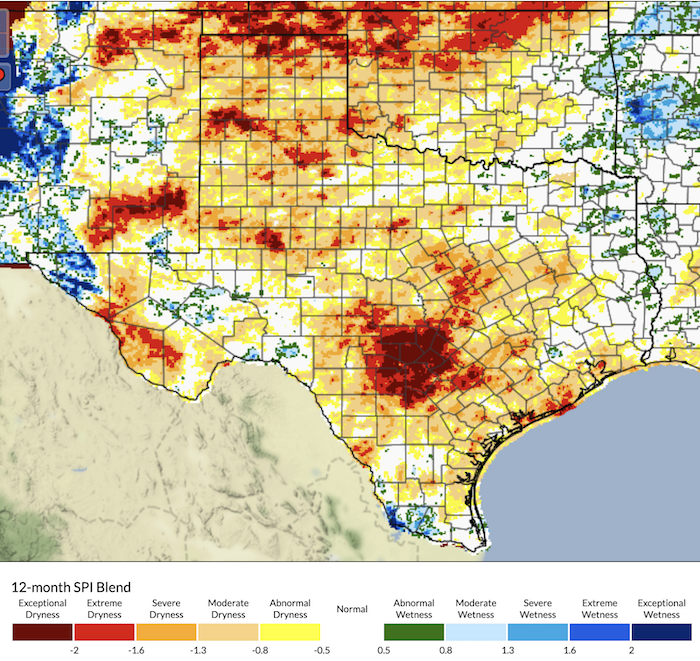
For More Information
- NIDIS and its partners will issue future drought status updates as conditions evolve.
- More local information is available from the following resources:
Prepared By
Joel Lisonbee
NOAA’s National Integrated Drought Information System, Southern Plains Drought Early Warning System and CIRES/CU Boulder
Gary McManus
Oklahoma State Climatologist, Oklahoma Mesonet, Oklahoma Climatological Survey
Matt Sittel
Kansas Assistant State Climatologist, Kansas State University
Alison Tarter
Texas State Climate Office, Texas A&M University
Southern Regional Climate Center
William (BJ) Baule
Texas State Climate Office, Texas A&M University
Southern Regional Climate Center
Victor Murphy
National Weather Service
This drought status update is issued in partnership between the National Oceanic and Atmospheric Administration (NOAA) and the offices of the state climatologist for Texas, Oklahoma, New Mexico, and Kansas. The purpose of the update is to communicate a potential area of concern for drought expansion and/or development within the Southern Plains based on recent conditions and the upcoming forecast. NIDIS and its partners will issue future drought updates as conditions evolve.







